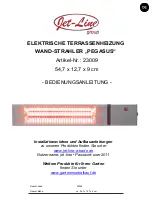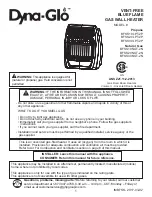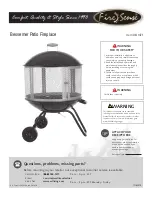
13
IGNITER AND ELECTRODE
Servicing of the igniter and electrode is needed when a
spark at the electrode is not seen. This may happen with
hard use over a long period of time, or due to dust or dirt
accumulation.
If you do not see a spark being generated at the electrode
check the following areas:
A. Igniter
1.
Pull the wire from the push button igniter.
2.
Place a metal object, (such as a screwdriver tip)
about 1/8 in. from igniter.
3.
Push the igniter’s button several times. If spark is not
seen, replace igniter.
B. Electrode
1.
Ensure the wire between the electrode and the igniter
is properly connected. All connections should be
good and tight.
2.
Check the wire for nicks, cuts, or mars. Nicks or cuts
will prevent a spark from being generated at the
electrode tip. Replace the electrode if necessary.
The electrode ships with the wire.
3.
Ensure the electrode tip is not out of position and is
not corroded. The tip should be located at the
midpoint of the pilot orifice and positioned so it
sparks across to the outside edge of the pilot orifice.
See Fig. 3.
4.
Verify that the electrode’s ceramic body is not
cracked and that the electrode tip does not move
within its insulative body. If it does, replace the
electrode.
BURNER ORIFICE
ATTENTION
■
Use only a soft brush, dry rag, or compressed air to
clean the burner orifice.
■
Do not push instruments into the orifice holes. As the
holes are drilled at a specific angle and diameter.
■
Doing so may distort or enlarge the holes, creating
improper combustion and burner flames extending
beyond the heater’s case barrel.
1.
In replacing the burner orifice, make sure the orifice
body and its holes are positioned properly. See Fig. 4
representing top view of burner. If the orifice body is
not positioned properly, the burner flame will not be
directed within the heater and improper combustion
may occur.
2.
The basic steps used in removal of the burner orifice
are the same as those used in removal of the pilot
orifice.
Fig. 4
ELECTRODE
BURNER
BURNER ORIFICE




































